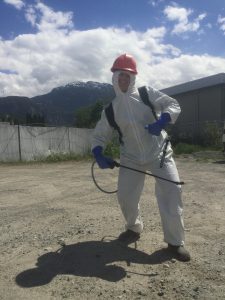In this installment of our Deep Dive Into the World Of Herbicides series, we look at spot spraying.
What is spot-spraying?
To put it simply, spot spraying is a method for applying herbicides, that limits impacts to non-target plants (our apologies if you came to this page looking for acne remedies…).
Spot-spraying usually involves a herbicide applicator conducting directed sprays using a precise handheld or backpack sprayer with an adjustable nozzle. The end-result is that the herbicide is applied only to the target plants (usually the leaves). Sometimes, depending on which herbicide is used, the applicator also applies herbicide to the soil immediately around the target plant’s stems, so that the herbicide can enter the plant through the roots, or prevent seeds from germinating.
Spot-spraying is different to broadcast spraying or boom spraying: those methods result in all vegetation in a given area being treated with herbicide. Our staff and contractors do not conduct large, broadcast spray or boom spray operations.

Ready for action with a backpack sprayer!
Why spot-spray?
Spot-spraying, along with other spot treatment methods (e.g. stem injection, wipe-on, etc.) are effective ways to remove invasive plants, whilst encouraging native and non-invasive plants to remain healthy and viable at a site.
Spot treatments are fast, effective, and only require a relatively small amount of herbicide to be used, therefore lowering treatment costs. Spot herbicide application also avoids soil disturbance or soil compaction, which can be detrimental to the long-term success of invasive plant management at a site.
And whilst spot-spraying can be a very effective option, herbicide treatment is only one tool in SSISC’s invasive plant control toolbox; for more information on this topic, you can check out this page.
Provincial government guidance
The South Coastal Mainland Invasive Plant Pest Management Plan, which SSISC follows, lists what herbicides can be used and how, on provincial public land. It provides sound recommendations for invasive plant management on any jurisdiction, so at SSISC, we follow this guidance as a general protocol. This plan includes and recommends ‘spot treatment’ methods, and the document includes a definition on p. 59.
For More Information
External Links
- BC Government, Integrated Pest Management Act, https://www.bclaws.gov.bc.ca/civix/document/id/complete/statreg/00_03058_01
- BC Government, Integrated Pest Management Regulation, https://www.bclaws.gov.bc.ca/civix/document/id/complete/statreg/604_2004
- BC Ministry of Forests, Lands, Natural Resource Operations and Rural Development, Invasive Plant Management Plan for Provincial Crown Lands in the South Coastal Mainland British Columbia (December 2020), https://www2.gov.bc.ca/assets/gov/environment/plants-animals-and-ecosystems/invasive-species/pest-management/pmp_south_coastal_mainland_21-26.pdf

